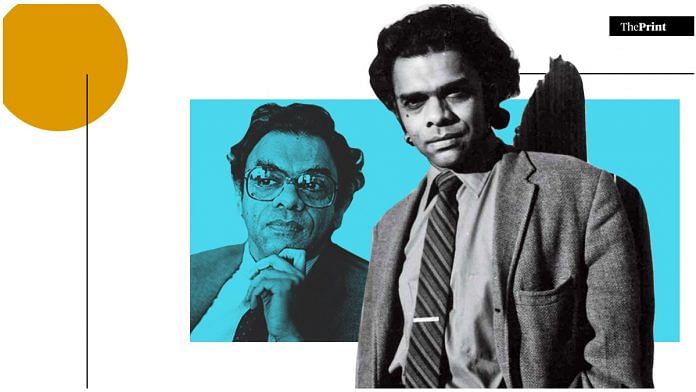“I would like to make a couple of observations about ‘modernisation’. One might see ‘modernisation’ in India as a movement from the context-sensitive to the context-free in all realms: an erosion of contexts, at least in principle,” wrote A. K. Ramanujan in 1989 in his now famous essay, ‘Is There An Indian Way of Thinking? An Informal Essay’.
With this seminal work, Ramanujan, poet, scholar, philologist, translator (he is well-known for his translation of ancient Tamil and medieval Kannada poetry and U.R. Ananthamurthy’s novel Samskara) and playwright, introduced a brilliant insight into the Indian ways of thinking. He argued that Indians had a very context-sensitive way of thinking whereas the Western world chose to live a context-free life. This was a departure from the conventional thought that dismissed the Indian way of thinking as merely traditional. His writings stand testament to the fact that he was extremely wary of conventions and was unafraid to experiment with thoughts and ideas.
In fact, his diary entries were written in third person where his hostility to conventional thought is evident. Sample this: “He was writing a poem. Definitely not about the raptures of roses and the languors of lilies. He would not be conventional, old-phrased, a Pandarus to the lazy public; no, not for the life of him.”
Born on 16 March 1929 in what was then Mysore, Attipate Krishnaswami Ramanujan went on to produce a huge body of literature, ranging from poetry and diary entries to folk tales and essays grounded in academic theory. Even though he explored literature in five languages — English, Kannada, Tamil, Telugu and Sanskrit — he was especially fond of his “two mother tongues”, Tamil and Kannada. Ramanujan started his professional career as a teacher in Madurai.
Soon, fed up with teaching, he enrolled in a linguistics programme at Deccan College, Pune, in 1958. But he always wanted to travel abroad and see the world.
On 1 July, 1959, he boarded the Strathaird, an ocean liner in Bombay, on a Fulbright Travel Fellowship to study at Indiana University, US. In 1962, he left for the University of Chicago. Later, he became a professor in the university’s Department of South Asian Languages and Civilisations.
On his 91st birth anniversary, at a time when India is grappling with the question of what it means to be Indian, it is worth revisiting his most famous essay.
Also read: Suryakant Tripathi Nirala — the poet who ‘freed’ Hindi poetry
‘Is there an Indian way of thinking?’
He begins the essay by asking whether there is a specific Indian way of thinking. What’s astute in his analysis is how he works out the meaning of the question itself.
“Depending on where the stress is placed, it contains many questions — all of which are real questions — asked again and again when people talk about India. Here are a few possible versions:
Is there an Indian way of thinking?
Is there an Indian way of thinking?
Is there an Indian way of thinking?
Is there an Indian way of thinking?
The answers are just as various,” he wrote.
In answer to the first question, Ramanujan argued that “there was an Indian way of thinking; there isn’t anymore”.
For the second question, he wrote that “there is no single Indian way of thinking; there are Great and Little Traditions, ancient and modern, rural and urban, classical and folk”.
In answer to the third question, he said, “What we see in India is nothing special to India; it is nothing but pre-industrial, pre-printing press, face-to-face, agricultural, feudal. Marxists, Freudians, McLuhanites, all have their labels for the stage India is in, according to their schemes of social evolution; India is only an example.”
And the fourth question points at whether Indians think at all. “It is the West that is materialistic, rational; Indians have no philosophy, only religion, no positive sciences, not even a psychology; in India, matter is subordinated to spirit, rational thought to feeling, intuition.”
‘Material-minded Indians’
Ramanujan was unafraid of calling out things as they were, even if it meant ruffling a few feathers. In January 2012, an academic body in Delhi University took the decision to withdraw an essay by Ramanujan, ‘Three Hundred Ramayanas’, because it had “incensed” right wing groups.
In the essay, he touched upon the need to be sensitive to context when it came to literary epics. “Scholars have often discussed Indian texts (like the Mahabharata) as if they were loose-leaf files, rag-bag encyclopaedias. Taking the Indian word for text, grantha (derived from the knot that holds the palm leaves together), literally, scholars often posit only an accidental and physical unity. We need to attend to the context-sensitive designs that embed a seeming variety of modes and materials.”
Ramanujan also called out Indians for being “material-minded” rather than “spiritual”. “Thus, all things, even so-called non-material ones like space and time or caste, affect other things because all things are ‘substantial’. The only difference is that some are subtle, some gross. Contrary to the notion that Indians are ‘spiritual’, they are really ‘material minded’.”
The poet
During his childhood in Mysore, Ramanujan religiously maintained a diary. His earliest known diary entry, titled ‘A Poem is Born’, was written in September 1949, when he was 20 years old.
His journal writing was interspersed with poetry. One is witness to this overarching trend even in his informal essays. In the paper, he wrote a poem to describe one of his father’s friends.
“Sky-man in a man-hole
with astronomy for dream,
astrology for nightmare;
fat man full of proverbs,
the language of lean years,
living in square after
almanac square
prefiguring the day
of windfall and landslide
through a calculus
of good hours.”
Also read: Girish Karnad’s last work was an unfinished autobiography in English



